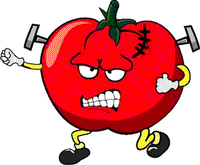July 17, 2006
Designing Food to Save the Planet
By Michael D. Shaw
Maybe genetic engineering got a bad name based on all those Grade Z 1950’s horror movies, replete with colossal ants, wasp women, and, of course, Godzilla. How else to explain the irrational opposition of some folks to improving the very stuff of life, even as the same protesters are cool with genetic engineering in the prescription drug arena? What cause could be more noble than providing adequate nutrition to the billions of starving people on our planet? You’d think it would be a slam dunk…
Welcome to the sorry debate over bioengineered food, where controversial “facts” and highly questionable theories mislead the public over one of the most promising developments in farming and science since crop management and pasteurization. Genetically-engineered food is the direct result of safer, more reliable and affordable agricultural policies, and is nothing at all like the hysterically named “Frankenfood” that opponents wield before reporters and television cameras.
Among other things, genetically-modified food helps retard soil erosion, and decreases reliance on potentially dangerous pesticides by creating a crop that can actually repel certain insects. And yet, in the developing world—where these products would enormously help the people of, say, Africa or the Asian basin—bioengineered food is virtually nonexistent.
It might calm popular fears to know that the introduction of foreign genes into plants goes back to the 1970’s, whereby the gene of interest is put into a bacterium that then inserts its DNA, including the new gene, into a plant cell’s DNA. Such work was to earn a Nobel prize in 1993 for the late Dr. Michael Smith. If you think about it, this is merely a higher-tech method of creating hybrid plants, a process that goes back at least 100 years. Selective breeding of crops, of course, dates back to ancient times.
Perhaps the most notable achievement within the realm of genetically altered crops to date occurred around 15 years ago, as products hit the marketplace with genes protecting against herbicides as well as insect pests. These plants now account for about half of all the cotton and soybeans grown in the United States, and one-third of the corn. You would think that modifying a crop, so that fewer pesticides would have to be employed, would be met with joy from the Green camp. To be fair, there is some support there, even if it is not, as one might logically assume, universal.
According to National Center for Food and Agricultural Policy—a nonprofit organization in Washington financed by the federal government, charities such as the Rockefeller Foundation, and several agricultural chemical companies—the use of transgenic cotton reduced insecticide use by two million pounds in 1998, or 12 percent of the total used nationwide on cotton.
In addition, agricultural biotechnology can improve a food’s nutritional content, as well as paving the way for entirely new products such as edible vaccines. Bioengineered foods strengthen the environment for many forms of wildlife, and discourage encroachment on rain forests.
Ultimately though, the biggest beneficiary of biotech crops is poor people. In Africa, where lack of rain can destroy more than 80 percent of the available food supply, bioengineered drought-tolerant crops would help feed hungry and malnourished populations. Genetically-modified food improves the lives of poor farmers in South Africa, India, China, and the Philippines, combating often voracious insects while at the same time reducing pesticide use or eliminating it altogether.
In the words of Gregory Conko, an economics and science writer, the benefits of biotechnology have not spread widely through the developing world because of foolish market restrictions. These policies come at the expense of our most needy citizens, all of whom would profit, both physically and financially, from bioengineering.
The strongest objections to “Frankenfoods” come from European elites, who have ignorantly conflated various food safety issues there (that had nothing whatever to do with bioengineering) and genetically-modified crops. It should be noted that most European countries do not have an equivalent to our Food and Drug Administration (FDA) regulating the field of bioengineered food.
Many of your favorite fruits and vegetables have been genetically-modified to provide such enhancements as controlled ripening (allowing better shelf life), fungal and insect resistance, viral resistance, improved nutrition, and heat stability.
To be sure, bioengineered food represents scientific progress, and should be promulgated more widely for the benefit of mankind.

